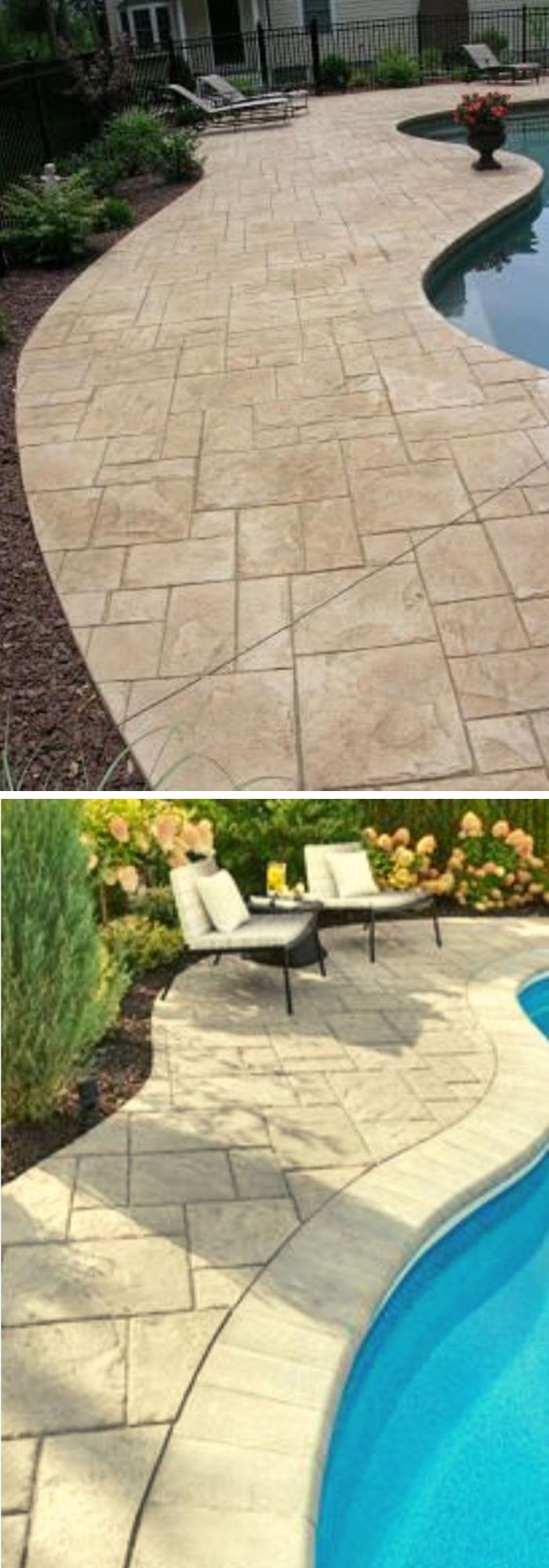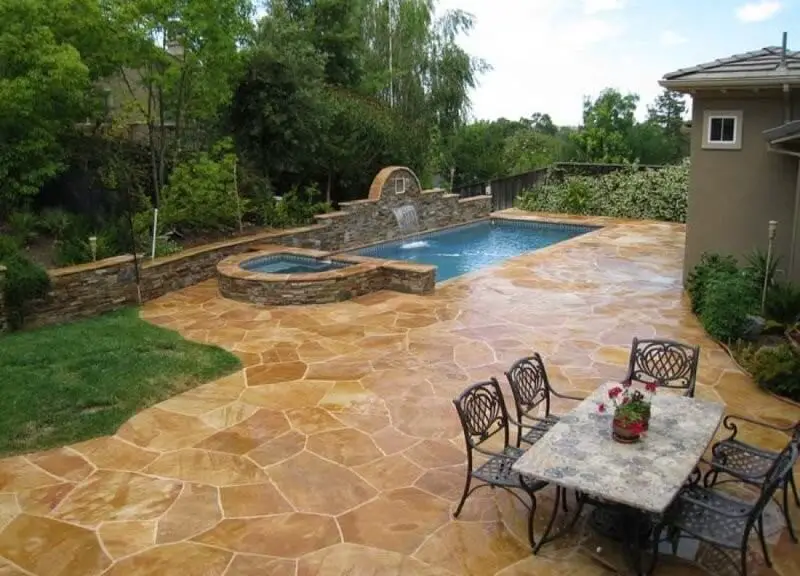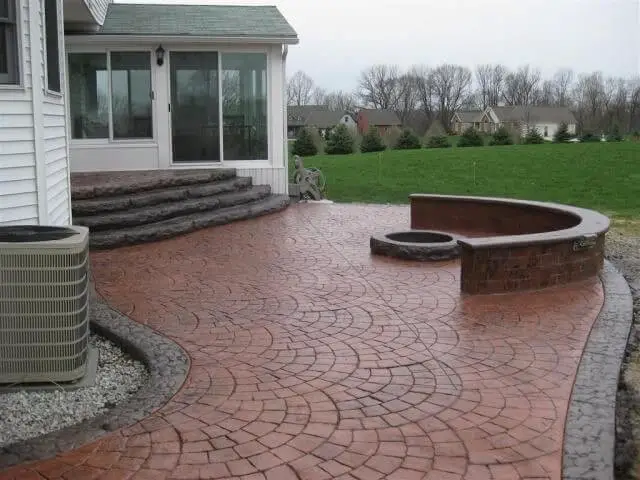18+ Best Stamped Concrete Patio Ideas
The popularity of stamped concrete patios has skyrocketed in recent times, and it’s not hard to see why. Not only do they add a unique touch to an otherwise dull grey slab patio, but they also offer several practical benefits. For one, they’re virtually weed-free, which eliminates the need for constant maintenance. Additionally, stamped concrete patios are often less expensive than traditional installation methods and can be done DIY-style with the right materials.
But what really sets them apart is their customizability. Homeowners have the freedom to design their patio in any style or pattern they desire, limited only by their imagination. And if you’re looking for some inspiration, [Stamped Concrete Houston](insert link) is always happy to lend a hand with installation and design. In fact, there are countless stamped concrete patio ideas out there, each one offering its own unique charm.
From fire pits to pergolas, and from pavers to pools, the options are endless. In this article, we’ll explore some of the latest trends in stamped concrete patios, including designs that incorporate elements like wood, stone, and even hot tubs. Whether you’re looking for a modern twist or a classic look, there’s something on this list for everyone. Stamped concrete patios offer several pros and cons, which will be discussed later.
But one thing is certain – they’ve quickly become the go-to choice for homeowners seeking a patio that’s both beautiful and functional.
How much does a stamped concrete patio cost?
According to Home Advisor, the cost of a stamped concrete patio can vary significantly depending on the complexity of the design. Basic designs featuring single patterns and colors typically fall within the $8-10 per square foot range. Intermediate designs with two to three colors and borders, on the other hand, tend to cost between $11-18 per square foot. High-end designs with intricate or elaborate patterns can range from $18-20 per square foot, primarily due to their increased complexity.
Additionally, high-end designs often incorporate various stones, further increasing their cost. When calculating the total cost of a stamped concrete patio, it’s essential to consider both the design and the amount of space that needs to be paved. For instance, pools and garden pathways may utilize intermediate-level stamped concrete, while lanais, entrance walkways, and backyard greeneries often require high-end designs.
How do you clean a stamped concrete patio?
When it comes to maintaining stamped concrete patios, a little effort goes a long way in preserving their beauty and durability. A regular cleaning routine is essential to keep them looking great. Start by sweeping and dusting the patio every three days to remove any loose debris. Then, dedicate one day a week to giving the entire surface a thorough mopping. This will help prevent dirt and grime from building up and causing stains.
According to industry experts at Concrete Works, most stains on stamped concrete patios are caused by exposure to changing weather conditions. If you notice any mild staining, you can usually remove it with a mild detergent. However, if the stain is more severe or appears to be grease- or oil-based (perhaps from parked cars), you’ll need to use an alkaline degreaser to get rid of it.
For rust-like stains, oxalic acid is typically the best solution for tidying up your stamped concrete.
And to maintain that beautiful shine, it’s recommended to reseal the surface every 2-3 years.
If you have an area with high foot traffic, you may need to apply a high-traffic floor polish every two months to keep the surface looking its best. For added visual guidance, check out this helpful video from Solomon Colors.
Stamped concrete patios pros and cons
While stamped concrete patios have their own set of advantages and disadvantages, let’s begin by highlighting the benefits. One significant pro is cost-effectiveness – as both Do It Yourself and ICS50 note, stamped concrete patios are generally cheaper than traditional pavers. Additionally, since it uses materials similar to those used in pavers, stamped concrete offers greater design versatility, resulting in higher aesthetic value.
Furthermore, you’ll no longer have to worry about weeding between the slabs of stamped concrete, eliminating a common hassle associated with paver patios.
However, there are some drawbacks to consider. Installation can be a more time-consuming process, especially for larger areas, as it requires specialized equipment. Moreover, maintenance can become increasingly tedious over time due to the presence of hard stains that may require specific cleaning compounds.
Regular sweeping and sealing are also necessary to maintain the patios’ appearance and shine.
Stamped concrete patio vs. pavers
While both stamped concrete and pavers can create stunning outdoor spaces, they possess distinct characteristics that set them apart. Stamped concrete patios boast a wow factor due to the numerous materials used, such as flagstones and brick stones, which offer endless design possibilities. In contrast, pavers showcase unique stone finishes and designs, giving them a classic look.
Notably, stamped concrete patios tend to be more slippery than pavers, although even pavers are not immune to this issue – according to Great Day Improvements, their materials can be skid-resistant. When it comes to usability, stamped concrete patios require longer installation times and more maintenance compared to pavers, which can be installed and enjoyed relatively quickly.
Finally, while pavers may be pricier, stamped concrete patios are generally cheaper to install, making them a more accessible option for many homeowners.
Wood stamped concrete patio
Wood-stamped concrete is a unique approach that combines the natural look of wood with the durability of concrete. By applying a specialized wood-like compound to the surface of the concrete, it’s possible to create a realistic wood plank appearance. However, this process requires significant time and effort, as well as specific equipment and expertise.
The staining process can be particularly labor-intensive, as it involves carefully crafting the knot or grain patterns that give the finished product its authentic wood-like texture. Despite these challenges, wood-stamped concrete is often used in high-traffic areas like pool patios, backyard spaces, and floor finishes, where a unique and attractive design is desired.
Types of stamped concrete patio
Stamped concrete patios can be categorized into three main types based on their complexity and design features. The basic type features a single color and pattern, with designs such as Brown Travertine, Herringbone, and Slate Skin Patio falling under this category. The intermediate type showcases two to three color combinations, often with borders and overlays, and includes designs like Shading Stamped Concrete, London Cobblestone, Ashlar Slate, and Flagstone Stamped.
High-end stamped concrete patios boast more than three color overlays, intricate borders, and elaborate etches, featuring designs such as Large Ashlar Slate Stamped, Blue Stone Stamped Concrete, and Brick Multi-Tone Cobblestone. Wood-stained or wood-stamped concrete patios occupy a middle ground between intermediate and high-end types, with design variations depending on the chosen wood pattern, colors, and borders.
Stamped Concrete Patio Ideas
#1. Stamped Concrete Patio With Fire pit




#2. Bluestone stamped concrete patio


#3. Stamped Concrete Patio With Pergola


#4. Wood stamped concrete patio


#5. Stamped concrete patio with pool

#6. Stamped concrete patio with border


#7. Stamped concrete patio with deck

#8. Stamped concrete patio with hot tub

#9. Flagstone stamped concrete patio


#10. Stamped concrete patio steps

Transitional stamped concrete patio

In temperate climates and for one-storey dwellings, transitional stamped concrete patios offer a practical solution. Characterized by a smooth, seamless transition from indoor to outdoor spaces, this design style employs smoothened acid-wash concrete slabs to subtly complement the home’s interior hues. The incorporation of slide doors or French windows further enhances the transition, creating a harmonious blend of interior and exterior environments.
White sheet metal concrete patio

This backyard patio design seamlessly integrates with an all-concrete, one-storey home to create a visually stunning and practical space ideal for sunny locations. The mid-century modern aesthetic is enhanced by the use of white sheet metal concrete, accented by artificial grass. To take the outdoor oasis to the next level, the design incorporates a small pool, inviting beach chairs, and a cozy ground fire pit.
Additionally, consider adding a compact outdoor bar or a dining table near the firepit for a truly ultimate summer patio experience.
Travertine stamped concrete patio

In recent years, installing travertine on top of concrete has gained popularity in outdoor design trends. This modern approach offers both aesthetic and functional benefits. For instance, using wood-textured concrete for a non-slip back deck, paired with rock inlays and lush greenery, can evoke an Asian-inspired oasis. Travertine is also an excellent choice for pool areas, as it helps minimize heat gain while being inexpensive to maintain over time.
Additionally, sealing the travertine allows for long-term durability and ease of upkeep, making it a practical option for patios.
Wood plank stamped concrete patio

Wood-planked concrete patios offer a unique blend of modern and rustic aesthetics, making them an excellent choice for creating a cozy outdoor space. The boardwalk panels used in this design add a touch of natural charm, while the non-slip surface provided by the wood plank texture ensures safety and stability. To complete the look, consider adding shade-providing elements like pergolas or large outdoor umbrellas.
A fire pit table or extended dining area can also serve as perfect accents, creating a warm and inviting atmosphere for outdoor gatherings.
Cobble stamped concrete patio

Cobblestone patios are timeless classics that never lose their charm. In this revamped outdoor space, the London cobblestones were cleverly laid on top of old concrete, creating a unique and functional surface. The cobblestones’ textured design makes them an excellent choice for areas with colder, wetter climates, as they prevent slipping hazards and efficiently absorb water.
To enhance the ambiance, consider incorporating mini bars, dining tables, or light workstations that blend seamlessly with the cobblestone terrain.
Random flagstone stamped concrete

The design takes its cue from the surrounding hilltop landscape, where irregularly shaped flagstones are laid over concrete to create a modern look. To add an extra layer of visual interest, consider using pea gravel or grass as dividers between the stones. For an even more striking effect, incorporating a lagoon-style pool or other water feature can complement the flagstone design beautifully. Additionally, extending the outdoor kitchen space can also be a great way to enhance this aesthetic.
European fan stamped concrete

The European fan design, characterized by its decorative stamped concrete motif, consistently delivers a timeless aesthetic. It’s no surprise that this style is frequently found in suburban colonial homes, where it’s often used as pavers or patio covers. When incorporated into stair treads and decked patios, the European fan pattern creates a visually appealing space.
In some instances, this design can be elevated by incorporating a concrete bench with a ground fire pit, all while taking in the expansive views of a large grassy area.
Herringbone stamped concrete patio

The Herringbone pattern, reminiscent of the European fan, offers a decorative concrete design ideal for in-lay use with pavers and patios. This design element seamlessly blends into the rustic charm of this Hispanic-Mediterranean-inspired patio, where a spacious dirty kitchen area invites family gatherings for weekend cooking sessions. The addition of a tall brick firepit and delicate lighting accents imbues the space with a distinctly Hispanic ambiance.
As the sun sets, the soft hues of the patio perfectly complement coastal homes, creating a warm and inviting atmosphere.
Rustic stamped concrete patio

Step into the heart of rural Italy, California’s rolling hills, or the Southern states’ picturesque farmland with a rustic stamped concrete patio that seamlessly blends into its surroundings. The key to achieving this look lies in the choice of materials, where large ashlar slabs were used here but other options like cobblestone or flagstones can also yield fantastic results.
To add an extra layer of texture and visual interest, consider incorporating pea or fine gravel as a divider between the slabs. The wood and climber pergola featured in this design adds a touch of organic charm, but a standalone wooden pergola or even just a simple shade structure would still create a welcoming atmosphere. For added coziness, pair your patio with rustic wood benches and tables, along with wooden bars serving as extensions to the space.
Ashlar slate stamped concrete patio

In this unique design, ashlar slates take center stage, covering the entire patio rather than serving as a border accent for larger flagstones. The focal point of the space is a lagoon-style pool situated at its heart, surrounded by palleted English fencing that echoes the concrete tone of the patio. To create an inviting atmosphere, consider adding an extended area covered in artificial grass, perfect for hosting barbecues, additional dining tables or beach chairs.
For added charm, a small pergola or shade structure can be incorporated, providing a cozy retreat from the sun.
Conclusion
In order to effectively decide on a stamped concrete patio, it’s essential to consider multiple factors. These include not only the upfront cost of installation but also ongoing maintenance costs, as well as the pros and cons of various alternatives to stamped concrete. Furthermore, understanding the different design options available will enable you to make an informed choice that meets your needs and budget.
Having a comprehensive grasp of the benefits and drawbacks of stamped concrete patios will ultimately save you time, money, and effort in the long run.
Related Posts
When it comes to making decisions about equipment for your farm business, choosing the right gear can be a daunting task. Similarly, installing a fence around your home requires careful consideration to ensure optimal protection. On the other hand, when it comes to tipping driveway sealers, understanding the etiquette surrounding gratuities is crucial.
Meanwhile, pursuing a career in landscape architecture or design can be an incredibly fulfilling path, while capturing the beauty of nature through garden photography requires a unique blend of artistic and technical skills.






